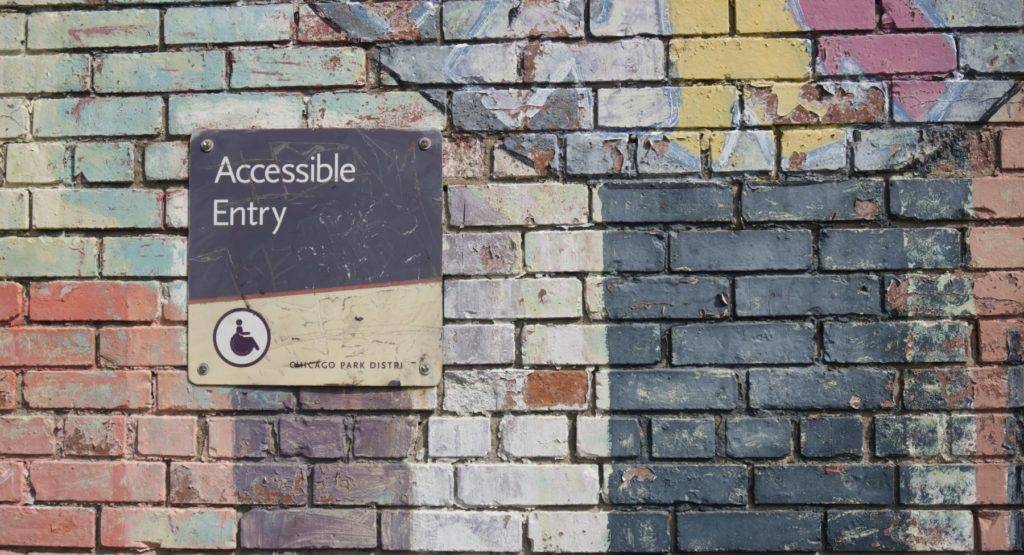
As many spaces as humanly possible should be accepting and safe for as many humans as humanly possible – and that includes kink spaces. Let’s talk about how to make your play space amazing for accessible BDSM.
This list of accessible BDSM tips was written for anyone who has any type of kink space where other, non-familiar people may be using it. Presumably, if you’re in a relationship or friendship with someone, you may already know what steps you can take to make your space great for accessible BDSM.
When you’re dealing with friendly unknowns, however, it can be harder to plan out – because you just don’t know the inner battles someone fights! You may have no idea that someone has difficulty standing because you assumed they just enjoyed sitting and watching scenes on our passing glances at your local club. You may have no idea that someone is partially deaf because they’ve never told you. And you have may have no idea that the snuggly grip one person always has on their partner is because of partial blindness exacerbated by the dark ambiance of most BDSM spaces.
Not all of these may be within your budget – and some of them may not work for your space. But, surprisingly, a lot of these accessible BDSM tips are more about your behavior and pre-planning than an increase in budget or space. This means dedicated metropolitan play spaces may be able to
I recommend these accessible BDSM tips to people who are:
- Running a dedicated BDSM dungeon in a commercial space
- Running a dedicated dungeon within a personal space
- Inviting kinky friends over, regularly, for personal parties
- People who host regular orgies, threesomes, or group activities with people they may not have a deep connection with
Remember: it isn’t the job of the person who needs a different space to tell you what they need. I feel like a lot of play space boards say “We’re definitely inclusive! If you let us know what you need, we’ll make it happen!”.
And to a point, that’s true. Everyone is responsible for meeting their own needs within reason.
BUT if someone has to publically disclose their personal needs in order to feel comfortable in your space, you’ve already missed out. You’ve already missed the mark on providing a comfortable, safe, inclusive, accessible BDSM space for all – because they didn’t feel welcome in the space you’ve created.
That person may choose to never attend again (instead of disclosing personal info). That person may just not feel safe or included in the first place. And for every person who reaches out to ask for accessibility options to be added in kink, another person just chooses to pass your space by. Not because they don’t want to be there – but because they don’t even feel physically welcome in your space.
Ouch.
Especially as kink spaces start to pop back up, I wanted to help make things as accessible as possible. And, of course, this list isn’t as exhaustive as I’d like. If you have other additions, please feel free to reach out! I’m happy to attribute additional suggestions to you (if you want). The idea is to make more accessible BDSM spaces – and I’ll take all the help I can get!
Remember: making an accessible BDSM space goes beyond simply wheelchair-accessible spaces. Inclusivity can include a wide range of different things – both mental and physical. Some things to think about:
- How people with anxiety can feel navigating your space?
- How people who may be hard of hearing can still use and communicate in your space?
- How people of extra-large or extra-slim body frames may be comfortable using your space?
- How people who have difficulty standing for long periods of time can use your space?
- How people who may have difficulty seeing can use your space?
- How people who have previous traumatic kink experiences will feel comfortable using your space?
- How people with various forms of PTSD can feel safe and avoid running into unexpected triggering circumstances?
Enough of my intro. Let’s dive into accessible BDSM tips.
Steps to Increase Physical Accessible BDSM
Ensure your play furniture has high weight limits. Have a master list of furniture weight limits somewhere in the space, and ensure that DMs know where this list is and can easily provide requested information. Preferably make this weight limit information available freely on the wall, on the furniture itself, or as posted information where your group communicates (like a Fetlife group or email group). This can help larger-bodied humans figure out if your equipment is safe for them – or modify their scene if it may not be.
Having lots of seating can be great from a participant standpoint, but it’s also just as great for accessible BDSM. Chairs allow people to rest, and they provide a great “excuse” to socialize outside of play areas. Include a few chairs within play areas as well, but socialization areas should probably have the bulk of your chairs. Don’t forget about weight limits and larger body accommodations. Chairs should be sturdy, and include a mixture of chairs without arms built-in. Couches can also be great additions to your social areas as they’re generally sturdier, encourage socialization, don’t require one “size” design, and can seem more welcoming. Remember: some people need chairs with arms to assist in standing while chairs with arms are also, simultaneously, not friendly to your large-bodied attendees.
Many buildings require accessible entrances now. If yours isn’t one of them or you’ve been grandfathered in and you don’t have the funds for major renovations, ensure you have a wheelchair-accessible ramp that’s safe and sturdy that can be placed over any steps. In addition, especially right before the play party, ensure you have an attendant who’s around to be able to add this piece to your building/area. Include contact information during your party information posts about how to contact someone to ensure this is ready. The idea is to make this as seamless as possible for those who need it if you don’t have the funds/budget/space to make your entrance permanently wheelchair accessible.
Ensure some of your play furniture is accessible from a seated position. This may be a modified massage table (hydraulic massage tables exist for easy adjustments), lowered spanking benches, or even play mats on the floor. Make sure that the implement storage/tables are equally lowered – or offer separately foldable, implement tables that are easily fetchable during a party. Camping tables can be A+ for implement tables. They fold up, are much lower to the ground, and still offer great implement space.
Ensure any “freebies” are accessible from a seated position. Do you have lube or condoms for party guests to enjoy? What about snacks, drinks, or water? Ensure these items can be reached by someone who is sitting.
As best as possible, ensure large, clear walkways that can fit wheelchairs, walkers, support canes, white canes, or other movement aids. This means ensuring people don’t gather (and ask them to disperse) within these walkways. These walkways need to be well outside the reach of the scene spaces. Think about where a flogger or whip could travel. Someone who uses a walking aid may not be able to easily dodge a flying whip tail at the last second.
Drag your feet along the floor of your various walkways. Especially if you set up speakers or power strips for play (like electrosex play), you might have cords hanging around – or maybe just that damn pesky rug that always moves around. Anything that isn’t flush with the ground can become a tripping hazard if someone doesn’t get the same stepping clearance that you do.
Make sure there’s a sight-based dungeon safeword that’s visible in addition to the standard audible “Red”. Make sure this safeword is also understood by ALL dungeon staff – and provide the object(s) to be used to ensure it’s always an expected visual. While the verbal “Red” may work for a lot of people, for non-verbal people, that isn’t going to work. I recommend waving a long, yellow ribbon – a neon version works great if you have black light. A waving flashlight will instantly stand out in a dark space, too.
Make sure there’s a sound-based dungeon safeword that’s audible within the noise-level of your dungeon too. This one can be hard – especially if you tend to have louder spaces filled with music. An air horn is probably overkill (and remember that it can really trigger those with traumatic pasts), but an electronic whistle can be a good option. It’s like a mouth whistle – but button-activated. Test it out during your usual music levels to ensure the Dungeon Monitors can hear it.
What does your bathroom look like? Restroom facilities are vital to everyone – but they can become a maze of difficulties and issues for people who rely on accessible BDSM spaces to access them. Can a wheelchair get into your restroom? What about on the toilet or reaching the sink? Do you have multiple restrooms available for people with IBS or other digestive issues? Is the extra toilet paper supply readily available just in case your current supply runs out? Is your bathroom gendered – and/or will people with non-binary genders feel safe and comfortable accessing however you’ve chosen to categorize your restrooms?
Steps to Increase Mental Accessible BDSM Options
Run a “beginner’s how-to” before any party – whether you have a “spoken up” newbie or not. Only running the how-to before parties where a newbie speaks up will ensure that some newbies squeak through because they don’t want to be the sole person to “force” someone to provide an optional talk they weren’t otherwise going to provide. Alleviate this concern and always have the how-to available with every party.
On that note, if possible, pass out physical copies of the rules – and a map of the space, if possible – to each person attending the newbie orientation. In large dungeon environments, it can be hard to hear – especially if the parties and music already started – and the last thing you want is someone not following the rule purely because they couldn’t hear the rule. Even if you think you’re speaking up, remember some people are hard of hearing.
(If you’re worried about theft or paper waste, laminate the notes with thick lamination. Much harder to run off with them, and it’s really easy to wipe them down. I recommend ending your newbie introduction at a cleaning station and asking each one to clean down their own copy of the rules for “practice” of how to clean things.)
If possible, have a physical poster of the dungeon rules right on the wall – in addition to how to contact someone outside of the party (Fetlife name/email) if someone has a private question or concern. Tear-tabs, like you see on Help Wanted boards, or business cards can be great for easy contact info.
Make all of your physical and mental inclusive practices known publically. Not only does this encourage other dungeons/playspaces to do the same, but it makes it easy for people who want/need these improvements to know what’s available.
Ensure any play that’s “commonly” triggering or problematic is done within a separate room or closed-off space as best as possible. Common examples of this may include consensual non-consent, electro play, takedown scenes, blood play, knife play, and even any scenes with loud noises or screaming.
If possible, dedicate one member of your staff to become an accessibility liaison who’s available to answer questions and provide information that someone may need to judge whether your space is a good fit for them. Ensure this person’s contact info (Fetlife name, email, whatever) is freely available on all mentions of parties.
When people bring up new issues you may not have solutions for (or maybe can’t afford), be transparent. Mention why it hasn’t been done (wasn’t aware, cost, etc.), and most importantly, ask “How can we possibly make this better for you within our limitations?”
If your space is large enough with separate areas, consider a low sensory area with no flashing lights, no loud music, and dimmed (but not dark) lighting. If this isn’t possible, consider having a special night every week or couple of months that’s focused on lower sensory play parties if it makes financial sense.
Do your best to ensure that your DMs are trauma-educated and have experience working with people of different backgrounds. DMs with mediation experience can be fantastic, too.
Ensure you have a process and procedure for dealing with any harassment or abuse. This is beyond the scope of this post (and honestly, needs thousands of words all to itself), but part of making your space feel like a safe space for attendees is ensuring that you’ve thought about their safety in case something nonconsensual happens to them.
If possible, open up volunteer slots for non-essential (but still helpful) duties for those with social anxiety. Having a “task” to complete can help those with social anxiety feel comfortable in a new environment. While you don’t want newbies helping with check-in due to privacy concerns, they can certainly help with refilling water bottles or cleaning down equipment and items. Many people with anxiety concerns may find it easier to acclimate to a new environment (your space) with a task at hand that allows easy/comfortable socialization but includes an easy “out” (“Oh, I have to get back to my job!”).
Accessible BDSM: Final Tips
Accessibility Isn’t a One-Off: Remember, newbies to your group will come and go in almost all circumstances. That’s the nature of any hobby group; real life occasionally gets in the way. This means that you can’t provide the information about accessible BDSM, once, six months ago, and never provide it again. Newcomers to your space will have zero idea about it! Make sure your accessible BDSM info is in an easy-to-see and easy-to-read area – preferably with reminders/links to it in every event notice.
Educate Your Staff/Volunteers: Your accessible BDSM efforts only go as far as your staff is aware of them. If you’ve done a lot of these things – but your one-off volunteers don’t know anything about it, they aren’t able to assist the attendees in utilizing the things you’ve done. Ensure all of the volunteers are familiar with the accessible BDSM options. Writing out a checklist of everything you offer to ensure you don’t miss anything is really ideal. (I know exactly how frantic setting up a play party can be.)







